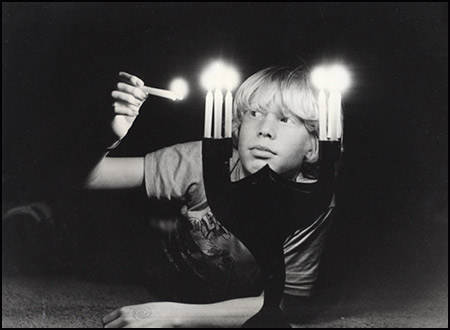
This story was first published in The Santa Fe Reporter on December 25, 1980. Since then Gunther and his wife, Geri Aron, have moved from Lamy into Santa Fe and will soon celebrate their 90th Birthdays! The photograph above, taken by Kitty Leaken in 1980, shows my Little Brother, Daniel Zimin, lighting a candle from the menorah that I had just purchased from Gunther.
To read Gunther Aron's "Recollections," please press this link. This link connects to Jim Terr's Blue Canyon Productions website which includes transcripts of Holocaust Survivors.
Northern New Mexico is well-known for its religious sculptures, particularly the Santos, or 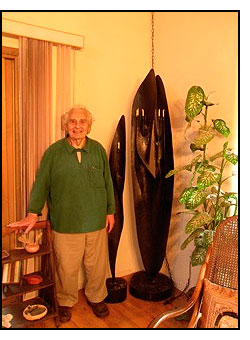 wooden statues of saints, which play an important part in Catholicism here. Jewish religious sculpture is a rarity.
wooden statues of saints, which play an important part in Catholicism here. Jewish religious sculpture is a rarity.
Nonetheless, 18 miles southeast of Santa Fe, in the small village of Lamy, Gunther has devoted many years sculpting Jewish ceremonial objects called menorahs in addition to making modern jewelry in silver and turquoise.
An eight-branched candlestick with an additional "servant" candle to light the others, a menorah is used particularly at Chanukah, the holiday which occurs around the same time as Christmas.
The eight lights of the menorah symbolize an event that occurred during the rededication of the temple in Modin during the winter of 163 B.C. The Jews were cleansing the temple after the crusading Greeks had defiled it by pagan sacrifices, and had only one small container of undefiled oil left, just enough to last one day. Miraculously, though, the oil lasted eight days, the entire period of the rededication ceremony.
Every year, Jews have joyously observed the rededication of the temple. The family gathers at sunset, the beginning of a new day in Judaism, and lights the candles on the menorah, one for each of the eight nights.
The menorahs that Gunther Aron creates — which are used in both private homes and synagogues — are made of welded steel, precious woods and metals.
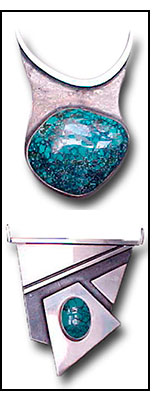 Aron lives and works in the town's old schoolhouse, an enormous adobe building he bought at public auction in 1968. His studio still carries with it reminders of the old schoolhouse in its blackboards, one of which bears in large letters the words, "Who, what, when, where, why?"
Aron lives and works in the town's old schoolhouse, an enormous adobe building he bought at public auction in 1968. His studio still carries with it reminders of the old schoolhouse in its blackboards, one of which bears in large letters the words, "Who, what, when, where, why?"
The menorahs which line the hallway of the former schoolhouse range from the very small to ones more than six feet tall. ''They are in fact," Aron says with a trace of a German accent, "actually sculpture to be enjoyed all year long."
Born in Germany in 1923, Aron spent the war years in England working in a munitions plant and attending evening classes at the Leeds Art School. He came to the United States in 1948, and settled down in Chicago's Old Town, an artists' district.
Although 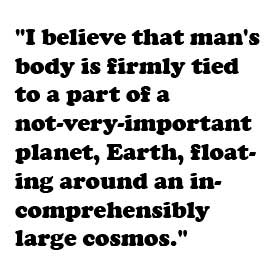 Aron was trained as a tool and die maker, his interest in sculpture and jewelry making eventually led him to study weekends at the Chicago Art Institute.
Aron was trained as a tool and die maker, his interest in sculpture and jewelry making eventually led him to study weekends at the Chicago Art Institute.
Later, he enrolled as a student at the Institute of Design — the Laszlo Moholy-Nagy offshoot of the famous Bauhaus in Germany. Although closed during the war by Hitler, during its heyday, the Bauhaus had trained and employed as instructors some of the greatest abstract artists of its time, like Klee and Kandinsky and the great architect, Walter Gropius who was its 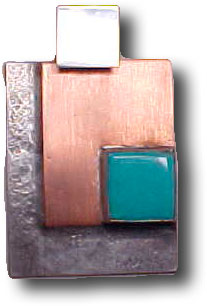 founding director.
founding director.
The early jewelry Aron made resembled, on a smaller scale, his current sculpture. "When I could no longer wear them," Geri laughs, "his jewelry became sculpture."
Actually, Aron says, he started creating large sculptures after he acquired a larger working space. "When my space changed from smaller to larger, so did my work," he says. His special interest in sculpting menorahs arose for the most mundane reason: "I wanted to save my wife a few bucks."
It happened during the 1950s, after years of making jewelry. Geri Aron was going out to buy some candlesticks, and that ignited the spark. "Stop," her husband said, "I'll make you some."
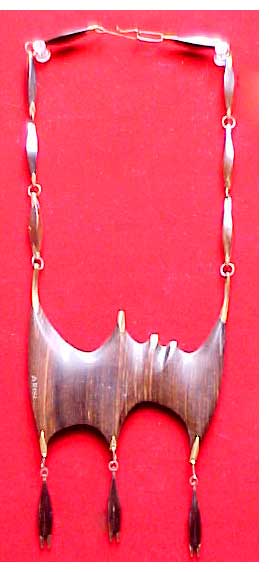 After the first pair turned out well, Aron decided to try to make money by selling them to the public. "If they didn't have hundred to buy sculpture, I figured they might have $25 to buy candlesticks," he says.
After the first pair turned out well, Aron decided to try to make money by selling them to the public. "If they didn't have hundred to buy sculpture, I figured they might have $25 to buy candlesticks," he says.
After a while, Aron began to incorporate candlestick after candlestick into his sculpture until he had six. "If I add two more candles, I'll have a Chanukah lamp," he said to himself one day, and so he did. Ironically, the menorah sculptor of Lamy, who has filled commissions for synagogues, is an atheist. Why did he decide to devote much of his life to the creation of the Jewish ceremonial objects?
"As a sculptor, I am comfortable with the symbolism of the menorah and what it represents," Aron says. The form of a tree, which he uses in his sculpture, is a symbol that appears throughout the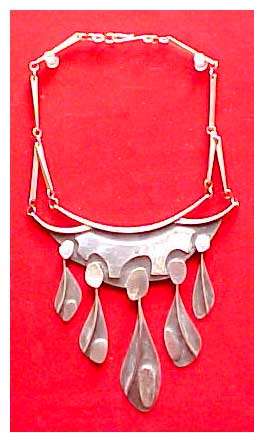 Bible.
Bible.
"But I no longer subscribe to those aspects of Judaism which I regard as superstitious, such as the dietary laws. I'm Jewish to the extent that I believe in Jewish ethics," he says.
"I regard myself as being part of the Earth," Aron says. "I believe to a very large measure that man is earthbound. I believe that man's body is firmly tied to a part of a not-very-important planet, Earth, floating around an incomprehensibly large cosmos."
The Arons decided to settle in this particular corner of the cosmos in the late 1960s, fed up with the air quality and crime rate in Chicago, and disheartened by the sight of old neighborhoods being torn down. "Everything was gone or going," 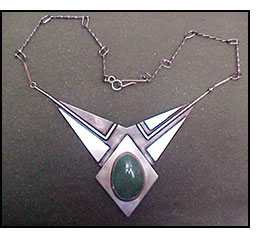 Aron recalls sadly.
Aron recalls sadly.
After an extensive search of places to live — via books with titles like "Where to Retire on a Small Income," "Where to Enjoy the Good Life on Little" and "Off the Beaten Path " — the Arons decided, after many visits to the Southwest, to set up shop in Lamy.
With his wife and a houseful of formerly homeless dogs, Aron works on his menorahs, cutting, 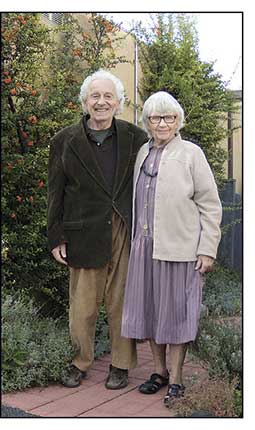 bending and welding steel in the seclusion of the old schoolhouse. The silence of the village is only occasionally broken by the sound of a train lumbering past. "I like the mountains and the wide-open spaces," he says, passing his fingers through hiswhite hair as he gazes into the clear New Mexican Sky.
bending and welding steel in the seclusion of the old schoolhouse. The silence of the village is only occasionally broken by the sound of a train lumbering past. "I like the mountains and the wide-open spaces," he says, passing his fingers through hiswhite hair as he gazes into the clear New Mexican Sky.
(Editor's Note:Although Gunther no longer has any menorahs for sale, he does have plenty of absolutely stunning jewelry pieces ranging in price from $175 to $900. Send Gunther an e-mail at gunthergeri@hotmail.com with Gunther Aron Jewelry in the Subject Line or just press this link! Samples of his inventory are shown in the story above.)
Thank you for visiting Chucksville. Please sign my guestbook.
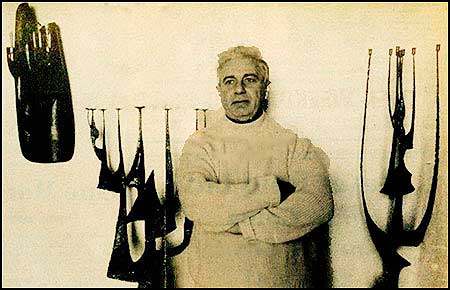
|
|
|
|


